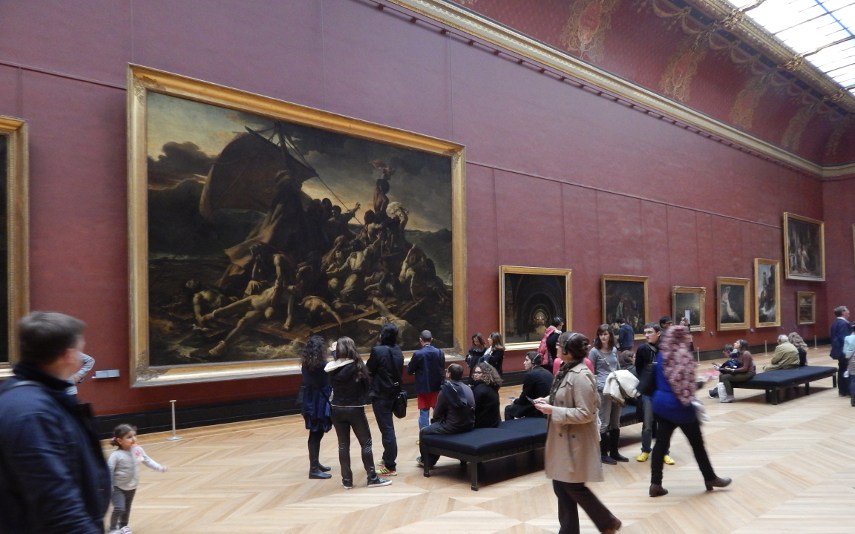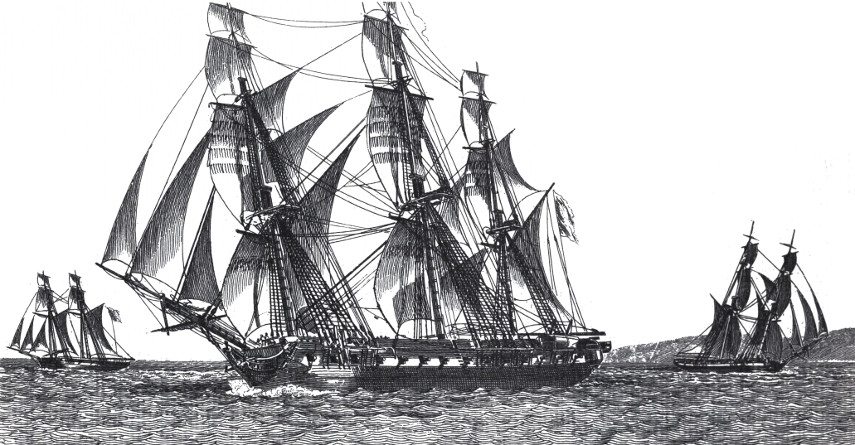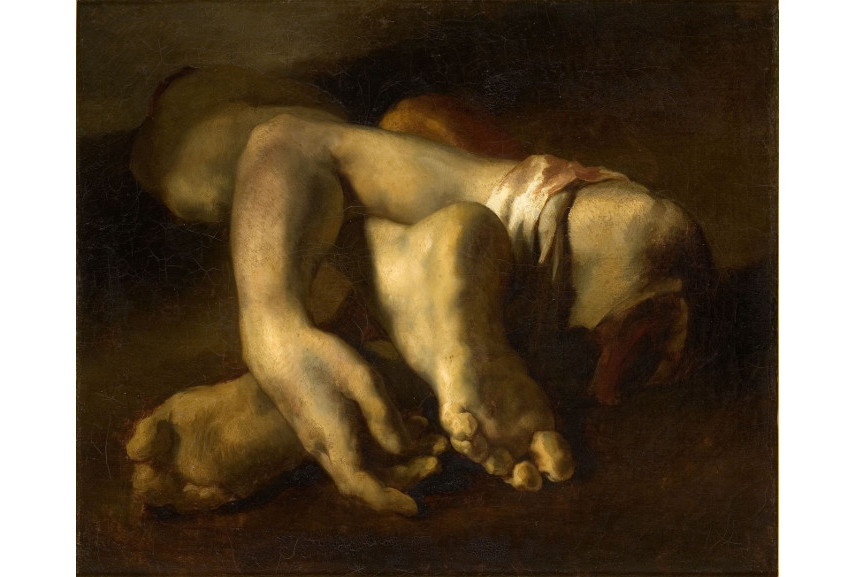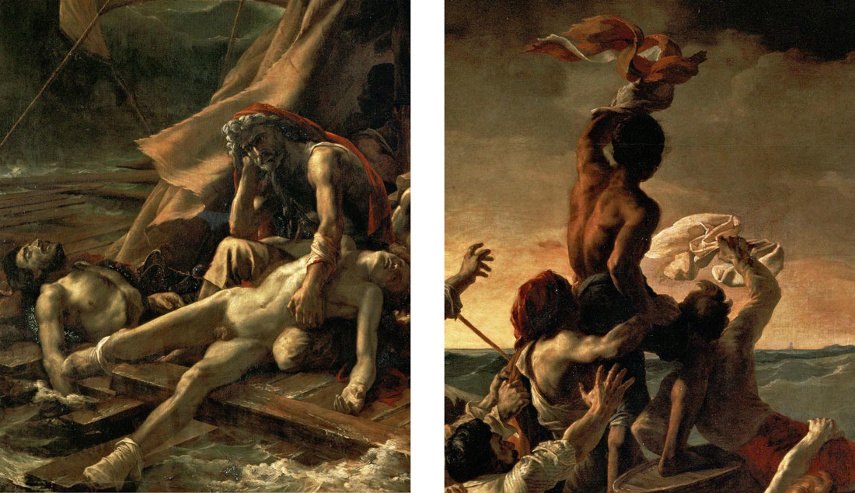He Raft of the Medusa Is Associated With What European Style of Art?
A piece that manages to capture the barbarous, accurate and raw emotion to the best of the medium'southward abilities, The Raft of the Medusa is an oil painting authored past the Romantic painter and lithographer Théodore Géricault in the year of 1818. Completed when the creative person was simply 27 years of age, this artwork has become an icon of Romanticism and therefore presents a truthful milestone of the European creative form.
The Raft of the Medusa is an over-life-size painting that describes a terrifying and exhilarating moment post-obit the aftermath of the wreck of the French naval frigate Méduse. The French public was outraged when it institute out what happened to the Méduse but was utterly shocked when they were presented with the painted version of the story - and make no mistake, French artistic community was never easily shocked.
Unmerciful and uncompromising in the depicted brutality, the desperation on sail is as devastating as the story behind the painting. Ultimately, The Raft of the Medusa became an inspiration for all the younger painters regardless of their visual preferences, quickly ascending to the iconic level[1] information technology still enjoys today.
We shall now accept a await at the backstory ofThe Raft of the Medusa, clarify it in detail and investigate how far reaching and potent its influence on the art history truly was.

The Event That Shocked the French Public
Information technology makes sense to outset with the event that served as the inspiration backside the piece as the knowledge of Méduse's fate is crucial in understanding the Théodore Géricault's artwork.
In the June of 1816, the frigate Méduse set up sail with three other ships, setting their class for the Senegalese port of Saint-Louis which had been given to the French past the British as a sign of good faith to the reinstated king, Louis Eighteen. Méduse held nearly four hundred people, besides as the new governor of Senegal. The function of the captain was given to Hugues Duroy de Chaumareys, a 53-year-old man who had not been on a ship for twenty-five years and had never commanded a frigate before in his life. Since the captain was inexperienced, all that the Méduse's crew were interested in was traveling as fast as possible and were sticking close to the African shoreline in order to practise so. The frigate quickly outpaced the other ships but it was only floating too shut to shore and inevitably hit a sandbar.
The coiffure decided to throw overboard actress weight in the hope of raising the send out of the muck and floating out with the tide. However, scared and inexperienced, the helm Hugues Duroy de Chaumareys forbid them from getting rid of the cannons as he did not want to anger his constituents back in France. Eventually, the send had hit the bottom of the ocean. The wealthy were given access and ample space on the lifeboats while the remaining 149 people were forced onto a makeshift raft which was tied by a rope to one of the lifeboats.
At some point, the raft was either intentionally or accidentally cutting loose. What followed was a 2-week nightmare of stormy seas, brutal killings, insanity and cannibalism. Out of all the crew members that were placed on the raft, just xv men survived the ordeal and 5 of them died shortly after their rescue came to exist. This tragedy became a major news event and scandal of its day, an international embarrassment whose crusade was widely attributed to the incompetence of the captain. De Chaumareys was court-martialed, and so acquitted considering the French feared ridicule from other nations for putting such a naive captain in charge.

Théodore Géricault and The Raft of the Medusa
Two years afterward the trial of De Chaumareys took place, the artist Théodore Géricault revealed his massive painting titled as The Raft of the Medusa. Eager to make a name for himself, the immature painter had thoroughly researched the subject by reading a pamphlet written by two of the survivors[2]. He went to hospitals and morgues to report both the dying and the expressionless, afterwards which he set a reconstructed raft out on the sea to see how it rode the waves.
Géricault even severed body parts taken from the local morgue which he allow decay in his studio and afterwards utilise them as references. Théodore also worked from live models and interestingly, the artist Eugène Delacroix was i of them. Delacroix's model is the corpse lying face down, arms outstretched, in the center of the composition.
However, there were many inconsistencies within the depiction despite the fact the painter did such a deep investigation of what truly happened. Many of these discrepancies were washed intentionally for dramatic consequence and compositional residual - for instance, there are twenty figures rather than the accurate number of fifteen.
At the 1819 Salon, the painting was retitled as The Scene of a Shipwreck in guild to avert harsh reactions from the French government; a somewhat surprising decision because how obsessed and dedicated Géricault was to the creation of the artwork[3]. Initially unable to find a buyer in his own land, Théodore exhibited the painting in continental Europe and England. A staggering number of over forty,000 people came to see the work in London and it was viewed with frightened fascination.
Eventually, the work did sell and information technology was saved past the French government from a group of French nobility who intended to cut it upwards and sell it piecemeal. The painting can now be seen at the Louvre. Information technology should be noted that Géricault died about five years after its completion at the age of thirty-two.

Analysis of The Raft of the Medusa
The Raft of the Medusa is an iconic Romantic painting that introduced the motion that effectively substituted Neoclassicism. As such, the piece independent all the features that defined what Romantic meant. Its style relies on the drama and fluidity of the Baroque motion and utilizes loose brushstrokes, a stiff and somber color palette, the precipitous contrast of light and night and dramatic poses.
As were nearly all Neoclassical and Romantic painters, Géricault was also strongly influenced by Michelangelo and therefore painted idealized, muscular bodies, which in this example are a strong contradiction to how the men truly looked. The sky and h2o are also definitely Romantic in nature every bit they draw drama, shadow and light, carrying the strong forces that these unfortunate humans are at the mercy of.
The massive size of the painting is in keeping with traditional historical pieces and their scales, although the subject here was a current event and, reverse to most historical paintings, there is no clear-cut hero(due south) - instead, nosotros are presented with victims.
Maybe the most striking feature of The Raft of the Medusa are the interlocking triangles, a mutual characteristic in Renaissance and Bizarre paintings, every bit well every bit a clear-cut indicator of Géricault's academic background[four]. The action is arranged in two distinct pyramidal shapes with 2 key peaks - the wave that may or may non engulf the survivors on the raft and the flag in the superlative correct corner that is raised in a last gesture of hope. The two pyramids serve to isolate the two distinct possibilities: rescue or massacre[5].
Furthermore, the people on the raft are subtly divided into four separate groups; the dead and dying are in the center, and so there are those struggling to stand upwards, a third group is comprised of three figures huddled together by the mast and the fourth group is capped by the African homo swinging the flag in agony. Studying the painting from left to correct, information technology'due south obvious that the physicality of the figures intensifies - however, it should be noted that this does non necessarily include the emotional drama as well. This is best evidenced past the despondent father who holds onto the trunk of his dead son in the foreground.

Why is The Raft of the Medusa So Inspirational?
Over the course of the last two centuries, it has never been disputed that the Théodore Géricault'southward masterpiece is a genuine landmark of modernistic painting and that it, as such, had a massive influence on many subsequent paintings.
However, listing all the reasons why it is so crucial is a challenging feat that we shall now attempt to attain. Kickoff of all, The Raft of the Medusa managed to practise what every painter wishes to attain with his or her piece - to inspire a new motility, to requite birth to a new style that will accept over the scene. Géricault managed to do and then every bit his masterpiece was the tiebreaker that allowed Romanticism to overcome the stone nature of Neoclassicism, directing the grade of French fine art history [six].
The Raft of the Medusa was as well 1 of the first pieces to feature a subtle social and governmental criticism, showing that artists can have an extremely loud voice if they desires to heighten it. Many subsequent pieces and movements were based on the criticism of some sort and The Raft of the Medusa was ofttimes the inspiration for such a human activity.
The limerick of the piece is also quite inspirational as this attribute of The Raft of the Medusa was dissected countless times, just as the case was with the greatest of paintings made ages earlier Géricault was even born. This masterful composition strongly influenced arts history and many of its representatives, inspiring them to put as much effort as possible to amalgam a perfect visual experience[vii].
Bated from doing this, Géricault has also allowed his limerick to become a part of the narrative. The two split up components of the pictorial composition refer to two possibilities doomed men of the raft take to expect forward to - rescue or expiry. This kind of subtle explanations really adds layers upon layers of meanings and materials to examine and explore.
Notable Artists Who Were Inspired past This Artwork
Due to the impact it had on the European scene, it comes as no surprise that many younger authors have created their ain versions and interpretations of The Raft of the Medusa.
Soon after its ascent to fame, shipwrecks and stormy seas became one of the favored subjects of Romantic painters. Pieces like Francis Danby'due south Sunset at Sea later on a Storm (1824), Eugéne Delacroix's The Barque of Dante (1822) and J. M. W. Turner'due south A Disaster at Sea (1835) were heavily influenced by Géricault.
Decades later on the expiry of Théodore, artists were still trying to recapture the emotion of Medusa, like the instance was with the Winslow Homer's The Gulf Stream (1899). Gustave Courbet also made many visual and artistic decisions by investigating The Raft of the Medusa. Honoré Daumier and Édouard Manet too saw Géricault every bit a source of inspiration, acknowledging thatThe Raft of the Medusa was a true stimulus and a valuable resource.
The Raft of the Medusa has as well inspired many of avant-garde and contemporary authors as well. Max Ernst, Vik Muniz, Sandra Cinto, Louise Fishman and Kristin Baker accept all created their ain variations of it. Martin Kippenberger fabricated an all-encompassing self-portrait series based on it and Paul McCarthy has proclaimed it one of his favorite pieces. Frank Stella, Jeff Koons and Peter Saul have too created artworks that reference Théodore'southward painting.
All of these artists choosing to reinterpret or adjust The Raft regardless from the time when they created their arts is a clear indicator of but how much Géricault was able to capture the imaginations of countless generations.

Editors' Tip: The Raft of the Medusa: A Novel
A novel based on historical fact, The Raft of the Medusa: A Novel reveals the turbulent life and work of Théodore Géricault, the bang-up 19th century painter and how he came to paint a masterpiece that publicized a tragic maritime scandal and ultimately influenced the development of the Romantic mode. Born to a rich and conservative provincial family, Géricault'south short being was a struggle to achieve rest and society amid the unstable forces that plagued his mind and emotions. A passionate affair with his aunt concluded traumatically with the long-curtained birth of their son, hastening the decline of a unique and provocative genius. All of the events from Géricault'due south life, both tragic and happy, culminated in the class of The Raft of the Medusa, i of the greatest pieces ever put onto a canvas.
References:
Featured Images: Théodore Géricault - The Raft of the Medusa, 1818/19 - Paradigm via wikimedia.org
Source: https://www.widewalls.ch/magazine/the-raft-of-the-medusa
0 Response to "He Raft of the Medusa Is Associated With What European Style of Art?"
Post a Comment